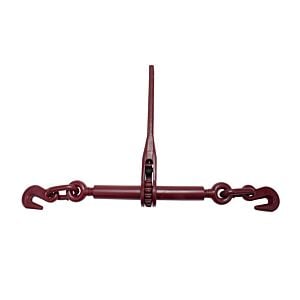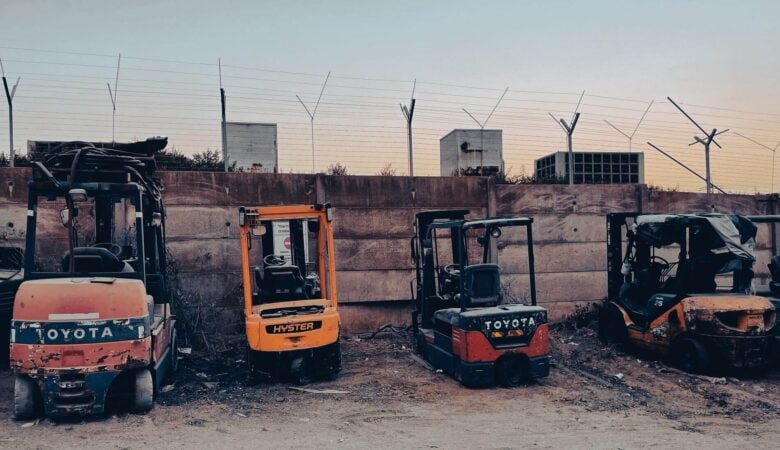Should you ever find yourself transporting heavy machinery or huge vehicles like a Bobcat, you’ll need a chain binder on hand. These tools help secure and transport your cargo. Chain binders are constructed out of forged steel and feature several end fittings. Even better, they come in a variety of styles, sizes and working load limits.
Though, there are generally two types of chain binders we’ll be talking about today for today’s blog; ratchet binders and lever binders. Each of these load binders has several pros and cons to consider. To know which is better, ratchet vs. lever binder comes down to what material you’re transporting and how you prefer to secure your cargo. By the end of this blog, you’ll be able to decide which chain binder makes the most sense for you.
What Is A Ratchet Binder?
As the name suggests, a ratchet chain binder uses a ratcheting mechanism to tension a chain over your heavy load. This style doubles down on your tie-down methods. Its screw and lever work in sync to apply force over your tie-down system. You won’t have to apply any real force on the handle either. Even better, you won’t have to work as hard to tension the chain to secure your load.
The ratchet binder’s pawls, handle and gear help reduce the chance of built-up tension forming over the handle. The chances of the bar hitting you in the face go from slim to none. At the end of the day, the ratchet binder comes as the safer and more controlled option.
What Is A Lever Binder?
On the other hand, lever binders use way fewer moving parts than a ratchet binder. They come equipped with only a lever and tension hooks on either side. This way, the lever can add more force when applied to your tie-down system. These load binders also make it easier and faster to unload your cargo. Basically, this style uses leverage to tighten and lock the chain in place when it’s rotated at 180 degrees. Overall, lever binders are easier to install, affordable, and more portable than ratchet binders.
However, they do have some drawbacks. This chain lever stores all of its energy in the handle, which means you have to use some serious strength to pull it. The added tension makes it harder to tighten the lever over your cargo because it takes a lot more force to do so. This built-up tension could lend to the extension bar snapping back on you when tightened or released. Hence the reason why it’s sometimes called a snap binder. Lever binders may be easier to use but they come with a major warning label.
Which Binder Is Best For Me? Lever Binder Vs. Ratchet Binder
At this point, you’re probably wondering which chain binder is right for you. It depends on a few factors; what type of cargo you’re hauling and what’s your preferred binding style.
For example, the FMCSA states that cargo that’s 5 feet or less requires one tie-down. However, if it weighs more than 1,100 lbs then you’ll need to use more tie-downs. Chain binders can act as more durable replacements for your tie-down straps and bungee cords, helping to tie down your equipment more efficiently.
Additionally, both types of load binders are great at helping to secure logs, hay bales, and military containers for transport. Though, ratchet binders are better at securing loads onto pallets in a warehouse setting. In the end, these two factors will help you make the right decision for your situation.
Here Are Some General Safety Tips To Keep In Mind

There’s nothing worse than a trucker using a chain binder the wrong way, especially in the case of a lever binder. Unfortunately, truckers work in challenging environments all the time that leave them bruised up and suffering from multiple fractures. These injuries derive from two problematic situations; they’re working overtime on the job or getting hit in the face by a lever binder.
That’s why it’s important that truck drivers keep a few safety tips in mind. They should regularly inspect their chain binders for any defects and fix them promptly. A nonfunctioning lever binder spells trouble. Also, make sure to operate the chain binder on a level platform. A lever binder requires some major strength and exertion so be prepared for the workout. Also, tighten and release the load binder manually, as using a cheater bar could be dangerous. Most importantly, stay away from the hitting range if the bar decides to snap back and go flying across the warehouse. Always practice safety first on the job.
Also Read: How to Use Chain Binders
Use The Load Binder That’ll Get The Job Done
Transporting your cargo can be difficult, but with chain binders, it can be a walk in the park. There are plenty of aspects to take into consideration when choosing a lever or ratchet binder to secure your cargo. As mentioned before, choosing the binder that’s right for you mainly comes down to what kind of load you are hauling. You want to choose the chain binder that offers the strongest tensioning. More importantly, one that’s easy and safe to use. It’s better to be safe than sorry in the end.
FAQs
Yes, the Ratchet Binder is the safer option. A Lever Binder may help you unload your cargo in record time but at the same time, you risk the extension bar poking your eye out. The Ratchet Binder has less built-up tension, which diminishes any chance of the bar hitting you or flying clear across the warehouse.
The two types of load binders are the Lever and Ratchet Binders.
Yes, Lever Binder and even over-center chain binders are illegal to use.















